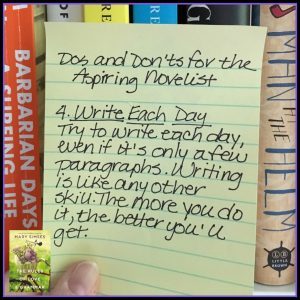Mary Simses's Blog
August 6, 2018
Interview with a Writer’s Assistant

Interview with a Writer’s Assistant
We recently sat down for a candid interview with Cinnamon, a Tonkinese cat who is the assistant to author Mary Simses.
Why don’t you tell us about your job?
I’m underpaid, unglorified, and underappreciated. What else do you want to know?
You sound a little irritated.
Of course I’m irritated. A simple, Thank you, Cinnamon, I couldn’t have done it without you, in one of her books would be nice. But so far, nothing. And, by the way, I’m working under horrible conditions. Sometimes my food dish is only half full. It’s clear I’m going to starve to death.
You look perfectly healthy to me. But let’s get back to the job. Can you give us some examples of what you do for Mary?
It’s a long list. How much time do you have?
Maybe you could pare it down to the essentials.
Well, the first thing I do is wake her up so she can feed me. And so she can do her work, of course.
Of course. How do you wake her up?
I begin with the usual meows and head nudges, and if that fails I escalate to stronger measures, like lying down across her neck or breathing on her with heavy tuna breath. That usually does it.
I can imagine. What happens after that?
After that I hang out in the kitchen while she has coffee and reads the newspaper. I like to jump on the table and stretch out across the paper, covering as much of it with my body as I can so she can’t read it. This forces her to pet me and give me the attention I deserve. Otherwise I don’t move. After that I might stare out the window or destroy a plant or try to catch an insect. Or groom myself for an hour.
What about the actual writing process? Do you assist Mary with that?
Of course. She likes to sit on a banquette in the bedroom and write at her laptop table. I curl up next to her and I’m ready to offer advice and encouragement at any time.
That sounds like a very important part of your job.
You better believe it. Do you know what a good muse is worth these days? Plenty. And I don’t care if you’re talking cash, Bitcoin, or catnip.
And you always give her advice?
Not always, but I’m available to do it. Seven days a week, all day long.
I know cats do a lot of sleeping. How can you be available all day? Don’t you ever fall asleep when she’s working?
Hmm. Well, I guess I sometimes fall asleep.
Sometimes?
All right, I often fall asleep.
Often?
Okay, okay. I always fall asleep. Let’s move on.
What other responsibilities do you have as a writer’s assistant?
I guard the laptop when Mary’s not using it.
What does that mean?
It means I lie down on the keyboard so the keys don’t get hurt by things falling on them or spilling on them. Haven’t you ever seen cats lying down on laptop keyboards?
Yes, but I always thought they did that because the keyboards are warm.
Oh, come on. That’s an old urban legend. We’re protecting the keys. A lot of cats do it without even being paid, which I think is wrong of course, but until we unionize ….
I understand. Well, Cinnamon, I appreciate your speaking to us. Is there anything you’d like to add?
Yes. Could somebody please deal with that stupid squirrel that comes to the window every day and mocks me? I’ve hoarded a big stash of treats and I’m willing to pay whatever it takes.
I’ll see what I can do.
July 1, 2018
Surrounded by Books
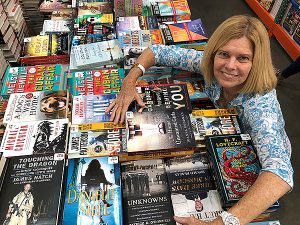 There’s nothing that makes me feel more like a kid in a candy store than being in a bookstore or in any store that sells books. I love having a stockpile of books on my night table, and even when I’m knee-deep in writing my own book, as I am now, I need to have a book to read. And yes, I did buy a couple of books the day this picture was taken.
There’s nothing that makes me feel more like a kid in a candy store than being in a bookstore or in any store that sells books. I love having a stockpile of books on my night table, and even when I’m knee-deep in writing my own book, as I am now, I need to have a book to read. And yes, I did buy a couple of books the day this picture was taken.
April 14, 2018
Hemingway at his Best/Worst
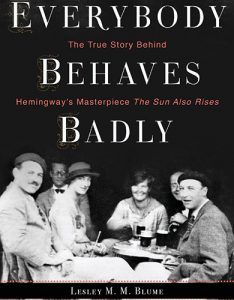 Full disclosure: I’m not that big of a fan of Ernest Hemingway’s writing, but I find him a fascinating person. Everyone Behaves Badly is an intriguing and well written book about Hemingway in Paris in the 1920’s, and the lead-up to the writing and publication of The Sun Also Rises, his first novel. It’s a look into how ambitious Hemingway was in his desire to become a successful published author and how his style – spare, lean, direct, and the opposite of what was being published at the time – took the literary world by storm.
Full disclosure: I’m not that big of a fan of Ernest Hemingway’s writing, but I find him a fascinating person. Everyone Behaves Badly is an intriguing and well written book about Hemingway in Paris in the 1920’s, and the lead-up to the writing and publication of The Sun Also Rises, his first novel. It’s a look into how ambitious Hemingway was in his desire to become a successful published author and how his style – spare, lean, direct, and the opposite of what was being published at the time – took the literary world by storm.
I’ve read other books about Hemingway, including The Paris Wife, which I also enjoyed, so I had an idea of what the Paris years were like. Everyone Behaves Badly filled in more of the details, especially about the friends and mentors (and other men’s wives, of course) Hemingway used in order to become successful. In addition to betraying his first wife (Hadley), by having a relationship with the woman who would become his second wife (Pauline), Hemingway betrayed his closest friends. He used their personalities and backgrounds to create the characters in The Sun Also Rises. And he was not kind when he created them.
Lesley Blume has done an excellent job distilling what must be mountains of information about this period in Hemingway’s life and presenting a portrait of a talented man who wanted to change the literary landscape with his new style. And did.
February 25, 2018
Rebecca: Still Mesmerizing
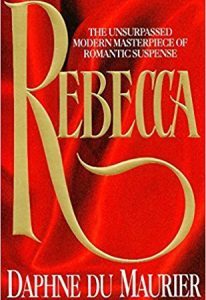 “Last night I dreamt I went to Manderley again.” So begins Daphne duMaurier’s classic novel of romantic suspense, Rebecca. I’ve read the book three times now – once as a teenager, once about twenty years ago, and again just recently. My daughter, who is nineteen, was sick and asked me to come into her room while she tried to go to sleep. I asked if she wanted me to read to her and she said yes. It’s a thrill to be able to read to a grown girl. She doesn’t ask for that often. I found Rebecca on her bookshelf. I knew she hadn’t read it, so I opened the book and began. She fell asleep within five pages, but I took the book back into my bedroom and continued reading by flashlight, so I wouldn’t wake my husband.
“Last night I dreamt I went to Manderley again.” So begins Daphne duMaurier’s classic novel of romantic suspense, Rebecca. I’ve read the book three times now – once as a teenager, once about twenty years ago, and again just recently. My daughter, who is nineteen, was sick and asked me to come into her room while she tried to go to sleep. I asked if she wanted me to read to her and she said yes. It’s a thrill to be able to read to a grown girl. She doesn’t ask for that often. I found Rebecca on her bookshelf. I knew she hadn’t read it, so I opened the book and began. She fell asleep within five pages, but I took the book back into my bedroom and continued reading by flashlight, so I wouldn’t wake my husband.
Rebecca takes place in England, where duMaurier was from. Her command of language is exquisite, and her descriptions of Manderley, the country mansion on the Cornish coast where the protagonist (she is never named!) goes to live with her new husband, are beautiful:
“We stood on a slope of a wooded hill, and the path wound away before us to a valley, by the side of a running stream. There were no dark trees her, no tangled undergrowth, but on either side of the narrow path stood azaleas and rhododendrons, not blood-coloured like the giants in the drive, but salmon, white, and gold, things of beauty and grace, drooping their lovely , delicate heads in the soft summer rain.”
duMaurier quickly drives the plot along – a young woman marries an older man whose first wife has drowned. She arrives at his estate as the second Mrs. de Winter, only to find that the first Mrs. de Winter, the beautiful and accomplished Rebecca, may be dead but is far from forgotten. Her suite of rooms is kept as though she’s about to walk through the door, her clothes are laid out and ready to be worn, and the sinister Mrs. Danvers, Rebecca’s servant, is ever loyal.
The book was written in 1938 and the writing reflects that period. Because of that, there are certain aspects of the story that don’t stand the test of time very well – the parts that deal with the legal system, police procedures, and the ferreting out of the truth from evidence, for example. The world of forensics as we know it didn’t exist back then. And the mores of that time were also very different from those of today. What was scandalous then would not cause an eye to blink now. But I didn’t mind that. I felt it a small price to pay for a wonderfully crafted book with gorgeous writing. In fact, I loved the idea of stepping back in time to a much more graceful and genteel world.
duMaurier has woven a story of mystery and intrigue and love. If you’ve never read Rebecca, pick up a copy. There’s a reason it’s still considered a classic.
November 20, 2017
At the Miami Book Fair 2017
 I had a great time at the 2017 Miami Book Fair, talking about my latest novel, The Rules of Love & Grammar, and sharing a panel with Elin Hilderbrand (left), whose latest novel is The Identicals, and Alisyn Camerota (middle), co-anchor of CNN’s New Day and author of the debut novel, Amanda Wakes Up. The panel, called “Finding Yourself,” was aptly named, as the main characters in all of the novels are trying to find their place in the world. I felt it especially relevant to me, as it took many years for me to find my way to the career I really love, which is being an author.
I had a great time at the 2017 Miami Book Fair, talking about my latest novel, The Rules of Love & Grammar, and sharing a panel with Elin Hilderbrand (left), whose latest novel is The Identicals, and Alisyn Camerota (middle), co-anchor of CNN’s New Day and author of the debut novel, Amanda Wakes Up. The panel, called “Finding Yourself,” was aptly named, as the main characters in all of the novels are trying to find their place in the world. I felt it especially relevant to me, as it took many years for me to find my way to the career I really love, which is being an author.
September 24, 2017
Revisiting Brideshead Revisited
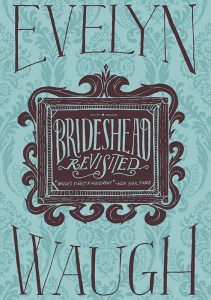 Back in 1981, I watched the British TV series that was created from this novel and broadcast on PBS. It was the vehicle that made Jeremy Irons a household name. I since found out that it took two years to make that 11-episode series, and if you watch it you’ll understand why. It’s so beautifully done. Every bit of it. Anyway, that’s how I fell in love with Brideshead Revisited the first time. After watching the series, I thought I’d better read the novel, and I did. I thought it was wonderful.
Back in 1981, I watched the British TV series that was created from this novel and broadcast on PBS. It was the vehicle that made Jeremy Irons a household name. I since found out that it took two years to make that 11-episode series, and if you watch it you’ll understand why. It’s so beautifully done. Every bit of it. Anyway, that’s how I fell in love with Brideshead Revisited the first time. After watching the series, I thought I’d better read the novel, and I did. I thought it was wonderful.
Fast forward a few decades. I’d thought about the story many times over the years, as it’s one that’s not easily forgotten. A month ago, I bought the DVDs on the Internet and binge-watched them over a weekend. After that – you know where this story is going – I bought
the novel again, because I have no idea where my original copy went. And I enjoyed it even more than I did when I first read it, presumably because I’m older now and have a deeper appreciation for all things (age must have some benefits, after all). You can find out more about the plot, the characters, the historical context, and all of that good stuff in other reviews, so I won’t repeat it all here. I’ll just tell you that it’s something you should read. And if you can get your hands on the PBS series from 1981, watch it. The folks who did it made the fabulous decision to stick very closely to the book and it worked. It’s magic.
July 26, 2017
Question about Blueberry Cafe Sequel
"Hi Mary. I loved The Irresistible Blueberry Farm. For me the book was much better than the movie. Is there going to be a second Blueberry Farm book? Thank you, Terry Freeman "
The answer is I'm just not sure. Although I loved my trip to the fictional town of Beacon, Maine, and really enjoyed creating the characters there, I also enjoy creating other fictional towns, such as Dorset, Connecticut, in my second novel, The Rules of Love & Grammar, and another fictional Connecticut town I've created for my novel-in-progress. It's possible I might return to Beacon in the future and tell another story through the eyes of another character, but at this point I'm just not sure.
I'm happy Terry sent me that question, as I get asked that fairly often. And I'm very happy she liked the book, and the movie as well.
July 18, 2017
How I Became A Writer
 I grew up in Darien, a suburban town on the Connecticut coast. When I was young I was always writing short stories and poems, and my teachers encouraged me to write – especially my ninth grade English teacher, who was one of two people to whom I dedicated my second novel. By the time I started college, I decided I’d better take up a practical career, as I didn’t think I could ever make a living writing fiction or poetry. I decided to major in journalism because at least that way I’d still be writing, although doing a very different kind of writing. I spent a couple of years after college working for a small trade magazine in Connecticut (fortunately, an interesting one that covered the field of magazine publishing), and then ended up going back to school to get a law degree. I worked for a law firm and then spent fifteen years working in the legal department of a large corporation in Westchester County, New York.
I grew up in Darien, a suburban town on the Connecticut coast. When I was young I was always writing short stories and poems, and my teachers encouraged me to write – especially my ninth grade English teacher, who was one of two people to whom I dedicated my second novel. By the time I started college, I decided I’d better take up a practical career, as I didn’t think I could ever make a living writing fiction or poetry. I decided to major in journalism because at least that way I’d still be writing, although doing a very different kind of writing. I spent a couple of years after college working for a small trade magazine in Connecticut (fortunately, an interesting one that covered the field of magazine publishing), and then ended up going back to school to get a law degree. I worked for a law firm and then spent fifteen years working in the legal department of a large corporation in Westchester County, New York.
It was during that time that I realized I had to start writing fiction again. I kept imagining scenes and thinking of dialog and I figured I’d either have to write or I would drive myself crazy not doing it. I enrolled in an evening fiction writing class at Fairfield University in Connecticut. And that was it. I was totally hooked again. I wrote “on the side,” whenever I could – late at night, on weekends, traveling, any time I could squeeze it in.
Over the next few years, several of my short stories were published in journals and literary magazines. Then my husband, also an attorney, was transferred to South Florida and we moved there. After that, I had our daughter, Morgan, and I put the writing away for several years, during which time we opened our own law firm. But, once again, I came back to writing fiction and began to work on more short stories. Jamie Callan, the author who had taught the fiction writing class I took at Fairfield University, had become a good friend and mentor, and she kept telling me I needed to write a novel. I didn’t believe I could take a character or an idea and spin it out for a few hundred pages. I think the longest story I’d written had been about thirty pages.
But one morning I heard something on the radio that changed all that. A woman was talking about how her grandmother had died, and how right before she died she said, “Erase my hard drive!” I don’t know what was on her hard drive or what the granddaughter ended up doing about it because I think I must have turned the radio off. I was fascinated with the idea of the grandmother and what secret she wanted to hide. Was she involved in organized crime? Did she have another family somewhere? Was she a spy?
I kept turning this over in my mind and I eventually came up with my own version – a grandmother whose dying request was to have her granddaughter deliver a letter. The letter was to a man in Maine, a man the grandmother had been in love with when she was young. I began to write the story and when I got to page 75 I knew I was writing a novel. It turned out to be the The Irresistible Blueberry Bakeshop & Café, which was also adapted as a film called The Irresistible Blueberry Farm for the Hallmark Movies & Mysteries Channel. After Blueberry Café, I went on to write The Rules of Love & Grammar and I’m currently working on another novel.
This is my third career and the one I’m keeping. I’m very fortunate to be able to do what I’m passionate about. It took me a while to get here, but I’m here!
July 5, 2017
10 Dos and Don’ts for the Aspiring Novelist
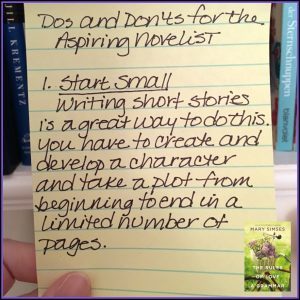 TIP NO. 1
TIP NO. 1
I thought I’d share a few thoughts about writing, from my own experience. So many people tell me they have a story they want to write. It can be done – I promise you. I started by writing short stories. For me, it was a less intimidating way to get back into fiction writing after a long hiatus than to try to attack a novel. Working on a short story trains you to come up with a beginning, middle, and end, develop characters, create dialog, and do it all within twenty or thirty pages. The chapters in a typical novel are like short stories, held together under the umbrella of a larger tale. So starting small is a great foundation for eventually writing that novel. TIP NO. 2
TIP NO. 2
Join a class of writing group. It worked for me! I took a fiction writing class at night at Fairfield University, while I was working as a corporate attorney, and that’s what got me back into writing as an adult. I wrote short stories in my “spare” time (at night, on weekends, on airplanes), had some of them published, and then finally tried my hand at a novel, which became The Irresistible Blueberry Bakeshop & Café.
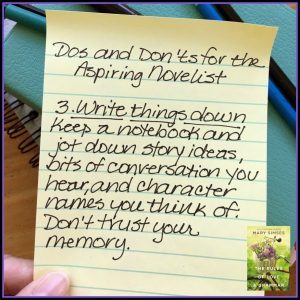 TIP NO. 3
TIP NO. 3
Keep a notebook and write down ideas you get for stories, characters, settings, dialogue, etc. I always have a pad and pen on my bedside table, because I’ve found that those brilliant thoughts I had just before I went to sleep evaporated with the morning light. When I’m writing a novel I also keep a binder with different sections for each of my characters. As I think of traits, habits, and other bits of their personalities I want to use, I write them down in there. Don’t trust anything to memory! It’s a fickle friend.
TIP NO. 4
In a 1997 interview with The Paris Review, composer and lyricist Stephen Sondheim said, “Art is craft, not inspiration.” I truly believe that. A writer becomes better by writing – by just grinding it out. It’s like any other skill. Athletes and musicians and artists all improve their craft by practice, and writers are no different. Sure, some people may have more innate talent at it than others – that’s the case with anything – but writers at every level can and will improve by writing. So try to write something every day. Work on that story or book you’ve got going, or just sit down and describe your favorite place to read or relax, or how the rain sounds on your roof at five in the morning, or the night your dog got attacked by a skunk and you had to buy all those bottles of tomato juice. You get the idea. Just write!
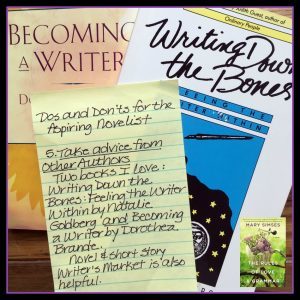 TIP NO. 5
TIP NO. 5
My good friend and mentor, Jamie Cat Callan, recommended several books to those of us who took her fiction writing class at Fairfield University years ago. The two at the top of the list were Writing Down the Bones by Natalie Goldberg and Becoming a Writer by Dorothea Brande. I bought them, read them, and loved them. And I still do. Jamie also recommended Novel & Short Story Writer’s Market, which I used a ton when I was sending my short stories to literary magazines, hoping to find a home for them. Some of them did find homes. And yours will, too. Keep writing!
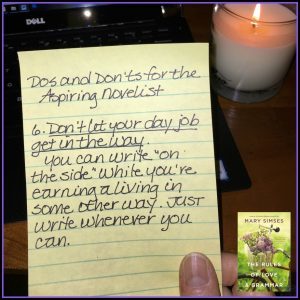 TIP NO. 6
TIP NO. 6
Even if you’re working in another job to pay the bills, you can still write. History is replete with stories of famous writers who had day jobs but wrote “on the side.” While composing his short fiction, James Joyce was a singer, pianist, and an English teacher in Europe. Robert Frost was employed in a light-bulb filament factory when he sold his first poem. Harper Lee supported herself by working as a ticket agent for two airlines. And the list goes on. When I was a corporate attorney, I wrote at night, on weekends, while traveling on planes, and at any other time when I could squeeze in a few pages or even a few paragraphs. It all adds up!
 TIP NO. 7
TIP NO. 7
It’s hard to be an editor of your own work, especially if you’ve created beautiful metaphors, dialog you feel is spot on, or descriptive sentences that just sing on the page. It’s tough to slice through your own sentences and press that delete key. But sometimes that’s what needs to be done, in order to move the story along, maintain the right tone, or improve the piece for any number of other reasons. What always helps me is to put my writing away and come back to it at a later time – even later the same day. I’m able to view it with fresh eyes and it’s easier for me to see and “hear” what needs to be fixed.
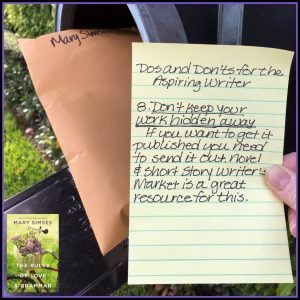 TIP NO. 8
TIP NO. 8
Keeping your work in a drawer or on your computer won’t get it published. You’ve got to send it out into the world. It may seem daunting, but the more you do it the easier it becomes. There are great resources out there, such as Novel & Short Story Writer’s Market, which provides information on magazine and book publishers and guidelines on what they accept, agents, writing contests, etc. And don’t forget local resources – I know people who have won writing contests sponsored by their towns or local organizations, and others who’ve pitched ideas for columns to their local newspapers and were hired to write them. When I returned to writing as an adult, I began with short stories, submitting them to literary journals I identified largely by using N&SSWM. I found the key was to always be sending out work. It’s like that saying: “If you throw enough spaghetti on the wall, eventually some of it will stick.” So increase your chances of something sticking – send the work out!
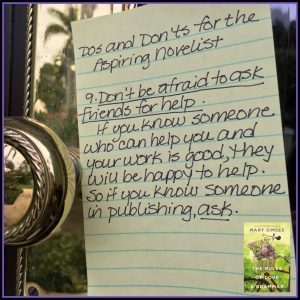 TIP NO. 9
TIP NO. 9
Sometimes it’s difficult to reach out to other people for help, but if you know someone who can assist with your writing career, ask. Most people are happy to lend a hand if they can, in terms of writing tips or publishing contacts or maybe even getting your manuscript to the right person. If you ask, you have a 50 percent chance of getting a “yes” response. If you don’t ask, your chance is zero.
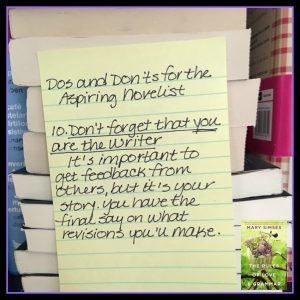 TIP NO. 10
TIP NO. 10
It’s been said that if you show a manuscript to ten different editors you’ll get ten different opinions. I don’t think that’s surprising, however, as we all have our own views of the world around us and of what we read. The key is to carefully consider the suggestions you receive from editors, other writers, avid-reader friends, and the like, and then decide which ones will strengthen the story or the characters and which ones you don’t feel are necessary or you just don’t feel right about. Be open to making changes, whether it means cutting or adding things you hadn’t considered. A good editor will come up with creative suggestions and explain why they make sense. A good editor will also be willing to compromise. So be ready to suggest alternatives. And above all, trust your instincts and don’t make changes your gut says you shouldn’t. Remember, it’s your story.
June 20, 2017
Postcards from Connecticut
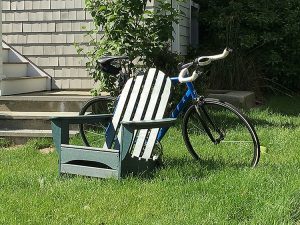 I’m in my home state of Connecticut doing some book events and enjoying the scenery. I passed this bike leaning on an Adirondack chair in Rowayton and had to stop and take a few photos. This picture really says “summer” to me.
I’m in my home state of Connecticut doing some book events and enjoying the scenery. I passed this bike leaning on an Adirondack chair in Rowayton and had to stop and take a few photos. This picture really says “summer” to me.
I liked the reflection of the flag in the window of this shop in Kent. There are some beautiful towns in Litchfield County, with lots of great scenes to photograph.
I took this on the way to Kent, just a few miles from town. It’s such a peaceful scene.
 Another photo from Kent, taken in town.
Another photo from Kent, taken in town.
 I love the way these kayaks look with all of their bright colors, waiting on the sand for some kids to come along and take them out on the water.
I love the way these kayaks look with all of their bright colors, waiting on the sand for some kids to come along and take them out on the water.
The red door of this church is striking. I think I was driving through Brookfield when I pulled over and took this. The whole church is beautiful.

